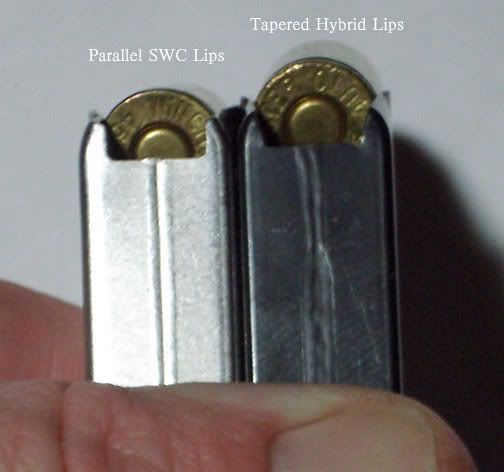A Degree
The first magazine I measured was a seventy year old Scovil,that was 20 deg.on the money,then all three different types from modern manufacturers and all regardless of configuration were consistently 20 deg.as well.
If you'll remove the recoil spring from a pistol and feed a round from a tapered/gradual release magazine slowly enough to see what the cartridge does, you'll notice something interesting that doesn't happen with parallel feed lips...something that isn't apparent with a static measurement.
The cartridge moves up at the rear as it moves forward...as though it's being lifted on a cantilever. By the time it's completely released, it's almost dead horizontal as it enters the chamber...with very little breaking over remaining.
But the angle of approach and entry isn't all there is to it, my one-eyed friend.
Look at the picture again. The rim at the left is a full 1/8th inch higher on the breechface than the one on the right...under the extractor...and the magazine hasn't even released it yet. "Controlled Feed" means just that. Controlled feed is the secret that makes the 1911 one of the most reliable designs to come down the pike...as long as full control is maintained.
Not all manufacturers seem to subscribe to the raised bump theory
That's mainly because so many people have been trying to outsmart Browning for so long, they really believe they have. Either that, or they flat don't understand why it was put there in the first place...or maybe both. I stopped arguing with Mose 35 years ago.
About 20 years ago, give or take...a friend of mine bought that little 5-dollar paperback by Ken Hallock. Ken advised removing the "pip" because he didn't deem it necessary...and he theorized that it was a hindrance to smooth feeding on the last round. "Joe" immediately began experiencing...issues...ranging from the slide locking back empty with the last round lying loose in the port...to loss of extractor tension that kept returning...and ultimately a broken extractor that broke again in less than 2,000 rounds. I fixed him up with a new extractor and loaned him a dozen magazines. His problems vanished along with the burrs on the edges of his rims that caused problems with his shell holders.
More recently, another friend from Tennessee that I met through THR was having several problems with nearly all his 1911s. I had to do a little actual work on a couple of'em...minor stuff mostly except for the one we dubbed "The Norinco from Hell." Mostly, I handed him a few of my magazines and watched the look of amazement come over his face. He thanked me publicly for "The Gift of Reliability" and it was mainly because of the magazines he'd been using.
the skirted type follower appears to be more of a reassuring feature than a usefulone,
The skirted followers appeared after the appearance of the Devel 8-round magazine that disappeared for a time, and was picked up by Chip McCormick and used in his Shooting Star magazines...and the same problems surfaced.
The follower wasn't stable because the rear leg only had two spring coils to nail it to the rear wall on the last round instead of three provided by the standard 7-round stick. It pitched forward and caused misfeeds on the last round, and it damaged aluminum alloy frames...something that the standard 7-round followers don't do. There were also common complaints of failure to lock the slide on empty. Chip responded with the Powermag, with a heavier spring...which helped, but didn't eliminate the problem. Needless to say that the unstable follower didn't do well at all with the dimple because the case rim dragged it forward with a vengeance.
Check Mate's Bull Nose (tm) follower is no more than the Kelsey/Devel follower with a skirt and a dimple on top. When they finally started using a decent spring...and extended the floorplate of the magazine one cartridge length, concealed with a false slam pad...their 8-round magazines started working. It took me 6 months to convince'em, but they finally threw in the towel on that extension, the full-length 11-pound spring, and the dimple. Their 8-round magazines...parallel or hybrid lips, as per buyer's choice...are constantly backordered. They're as good as any I've tried.
It's time to point out that I have no financial interest in Check Mate Industries, and I receive no compensation from them beyond the half-dozen magazines that I got for beta testing and input. They've since been passed along to other testers...as per the agreement...and I don't have them any more. CMI could go belly up or it could come to dominate the magazine market, and it wouldn't affect my portfolio one penny's worth. All I got for the GI feed lip gauge was a "Wow! Thanks!" But it's ai'ght.
The "Hybrid" design was all Colt's, and in addition to CMI, they've also had contracts with Metalform and OKAY for the magazines. It's just that CMI is the only vendor that will sell them to the general public without the Colt logo, unless you happen to catch Metalform with a few overruns from a filled contract without the horsie on the floorplate...but don't expect to score more than a half-dozen at best.
interesting to mention is the the convex type which appears in some Wadcutter type magazines.
Do you know what single function the convex follower performs that the flat follower doesn't? It's more of a band-aid that compensates for a lack of something than anything else...and that advantage is compromised by the use of an extended ejector, even if it doesn't touch it.

